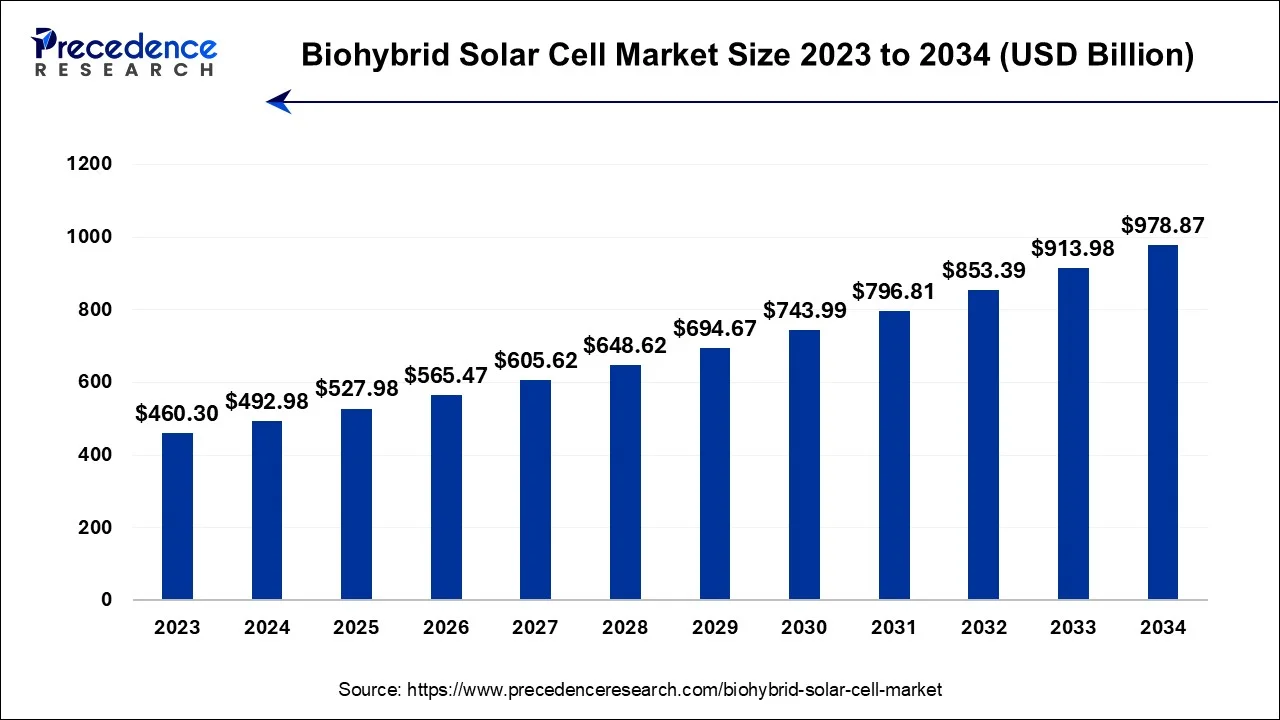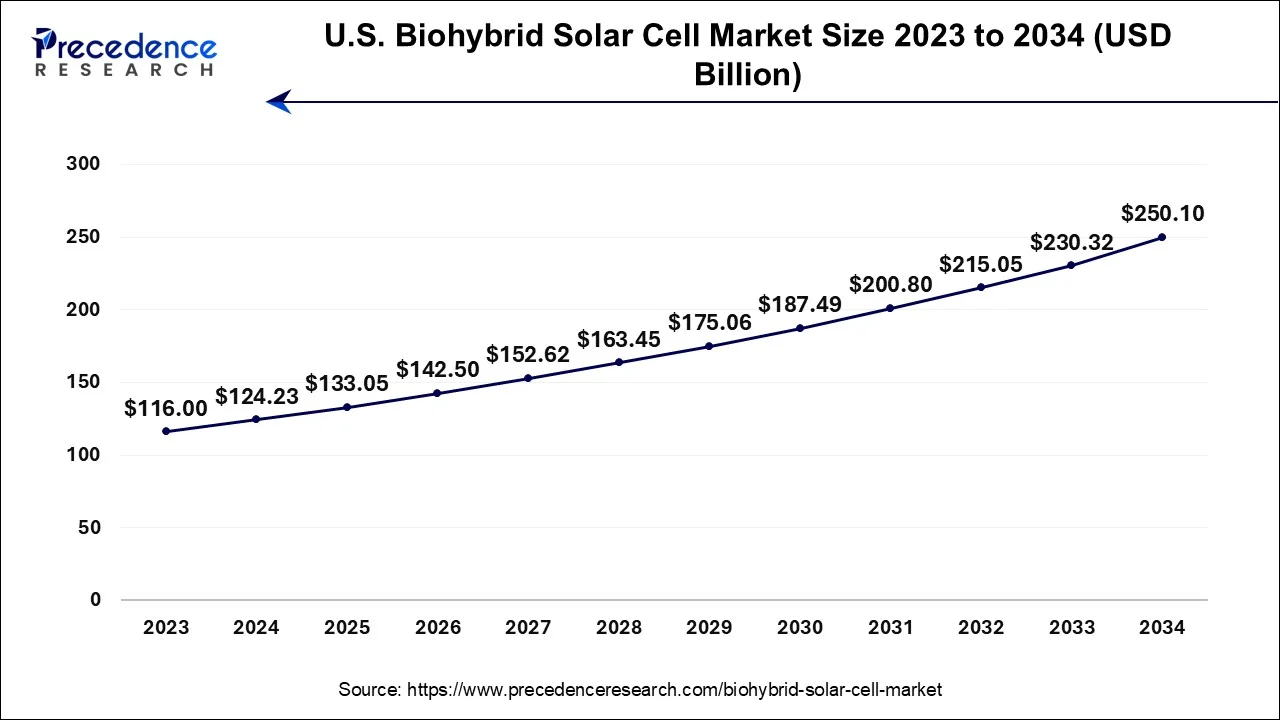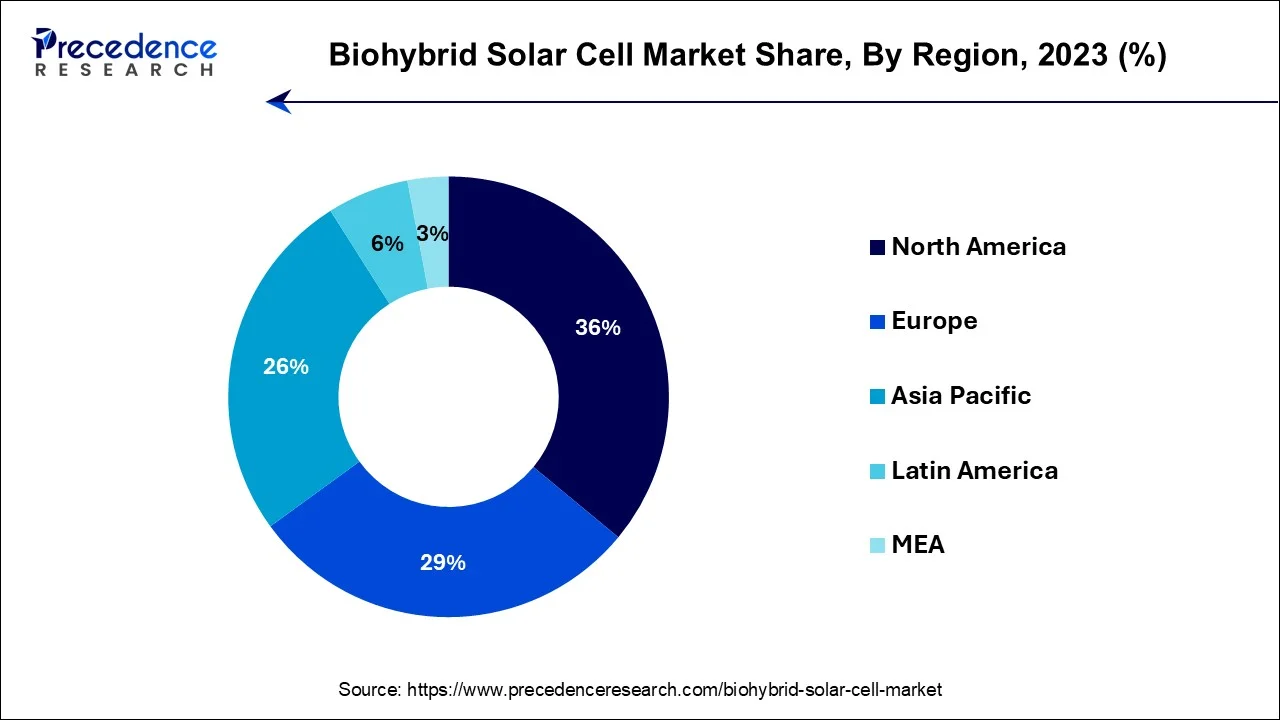Biohybrid Solar Cell Market Size and Forecast 2024 to 2034
The global biohybrid solar cell market size is estimated at USD 492.98 billion in 2024 and is anticpated to reach around USD 978.87 billion by 2034, expanding at a CAGR of 7.10% between 2024 and 2034.

Biohybrid Solar Cell Market Key Takeaways
- North America led the market with the highest market share of 36% in 2023.
- Asia-Pacific is projected to grow at the fastest CAGR during the forecast period.
- By Material, the silicon crystal coatings segment contributed more than 41% of revenue share in 2023.
- By Material, the cadmium telluride coatings segment is expected to grow at a remarkable CAGR of 8.2% during the projected period.
- By Application, the battery storage segment held the biggest market share of 29% in 2023.
- By Application, the solar cells segment is estimated to expand at the fastest CAGR over the projected period.
U.S. Biohybrid Solar Cell Market Size and Growth 2024 to 2034
The U.S. biohybrid solar cell market size accounted for USD 124.23 billion in 2024 and is expected to be worth around USD 250.10 billion by 2034, at a CAGR of 7.25% from 2024 to 2034.

North America has held the largest revenue share 36% in 2023. North America has witnessed a growing interest in the biohybrid solar cell market. The region is characterized by a robust research ecosystem and a commitment to sustainability. Research institutions and companies are collaborating to develop more efficient and scalable biohybrid solar cell technologies. Moreover, governments' focus on renewable energy solutions and investments in green initiatives are driving the adoption of these cells.

Asia-Pacific is estimated to observe the fastest expansion particular focus on countries such as Japan and India, is showing a strong commitment to clean energy solutions. The biohybrid solar cell market is experiencing a surge in research and development activities aimed at improving the efficiency and scalability of these innovative solar cells. Furthermore, the region is increasingly recognizing the importance of environmental sustainability and the demand for innovative energy sources. These factors are collectively propelling the growth of the biohybrid solar cell market, positioning the Asia-Pacific region as a promising center for advancements in this field.
Market Overview
Biohybrid solar cells are a type of renewable energy technology that combines the principles of synthetic biology and photovoltaics. These innovative solar cells employ organic materials and living organisms, such as photosynthetic proteins or algae, to harness sunlight and convert it into electricity. The biohybrid approach leverages the natural photosynthetic processes of these biological components to capture solar energy efficiently. This technology holds promise for sustainable and environmentally friendly energy generation, as it can overcome the limitations of traditional photovoltaic cells.
Biohybrid Solar Cell Market Growth Factors
The biohybrid solar cell market is a revolutionary fusion of synthetic biology and photovoltaic technology, offering a potential transformation of the renewable energy sector. These innovative solar cells utilize organic materials and living organisms, such as photosynthetic proteins or algae, to harness sunlight efficiently and convert it into electricity. Key drivers propelling the growth of the biohybrid solar cell market include the increasing global demand for sustainable energy sources. As the world seeks eco-friendly alternatives, biohybrid solar cells provide an enticing solution.
However, the industry faces notable challenges, including the imperative to improve the efficiency and long-term stability of biohybrid solar cells to match traditional photovoltaic technologies' performance. Additionally, scaling up production while maintaining cost-effectiveness remains a significant hurdle. For businesses, the biohybrid solar cell market offers promising opportunities, providing sustainable and environmentally responsible energy generation options. Companies in both biotechnology and solar industries can diversify and expand their portfolios by investing in biohybrid solar cell technology, aligning with the growing emphasis on clean energy and environmental sustainability. As technology matures and tackles current challenges, biohybrid solar cells are projected to revolutionize the future energy landscape.
Market Scope
| Report Coverage | Details |
| Growth Rate from 2024 to 2034 | CAGR of 7.10% |
| Market Size in 2024 | USD 492.98 Billion |
| Market Size by 2034 | USD 527.98 Billion |
| Largest Market | North America |
| Base Year | 2023 |
| Forecast Period | 2024 to 2034 |
| Segments Covered | Material, Application, and Region |
| Regions Covered | North America, Europe, Asia-Pacific, Latin America, and Middle East & Africa |
Market Dynamics
Driver
Growing demand for sustainable energy and advancements in biotechnology
The biohybrid solar cell market is experiencing a surge in demand, primarily driven by two major factors: the growth in the global need for sustainable energy sources and significant advancements in biotechnology. The escalating demand for sustainable energy solutions is steering the market's momentum. increasingly conscious of environmental issues and the need to transition to clean energy, biohybrid solar cells have emerged as a compelling option. These cells harness the power of organic materials and living organisms, making them an eco-friendly choice for renewable energy generation. With sustainability at the forefront of energy agendas, biohybrid solar cells are meeting the desires of consumers and industries seeking greener alternatives.
Moreover, the remarkable progress in biotechnology, synthetic biology, and genetic engineering is revolutionizing the capabilities of biohybrid solar cells. Researchers are continuously enhancing the efficiency, stability, and scalability of these cells through innovative biological components and materials. These breakthroughs are driving market demand as businesses and consumers increasingly recognize the potential of biohybrid solar cells as a sustainable, efficient, and adaptable energy solution. Together, these factors are propelling the biohybrid solar cell market into a position of prominence in the renewable energy landscape.
Restraints
Competition from conventional solar and scaling up production
The biohybrid solar cell market faces notable challenges stemming from competition with conventional solar technologies and the need for scalable production methods. First and foremost, the established dominance of traditional solar panels, such as silicon-based photovoltaics, presents a significant restraint. These conventional technologies have a longer track record, higher efficiency, and lower production costs.
As a result, they pose intense competition and often outperform biohybrid solar cells in terms of efficiency and reliability. This competition from well-established solar solutions can limit the adoption of biohybrid cells, particularly in markets where the emphasis is primarily on cost-effectiveness and performance.
Another substantial challenge is the need to scale up production while maintaining cost-effectiveness. Biohybrid solar cells often involve the use of biological materials and living organisms, which can introduce complexities and variability in production processes. Achieving large-scale and consistent manufacturing is crucial to making biohybrid cells commercially viable.
This scaling-up process demands significant investment in research, development, and production infrastructure, potentially raising the overall cost of biohybrid solar cells. These challenges highlight the importance of addressing efficiency, scalability, and cost-effectiveness to overcome competition from conventional solar technologies and drive broader market demand for biohybrid solar cells.
Opportunities
Environmental sustainability and collaborative research
Environmental sustainability and collaborative research efforts play pivotal roles in surging the demand for the biohybrid solar cell market. There is an increasing imperative to transition towards sustainable energy sources owing to pressing concerns regarding the environment globally. Biohybrid solar cells, with their capacity to harness sunlight through organic materials and living organisms, offer a unique and environmentally responsible solution. This aligns perfectly with the global push for cleaner and greener energy alternatives.
Collaborative research initiatives between biotechnology and solar technology companies are driving innovation and advancing the capabilities of biohybrid solar cells. By pooling expertise from these diverse fields, researchers can explore novel materials, biological components, and engineering techniques. This collaborative approach accelerates the development of more efficient and scalable biohybrid solar cell technologies, making them increasingly attractive for commercial and residential applications.
The synergy between environmental sustainability and collaborative research not only meets the demand for clean energy solutions but also propels the biohybrid solar cell market towards a brighter and more sustainable future.
Impact of COVID-19
The COVID-19 pandemic had both direct and indirect effects on the biohybrid solar cell market. Initially, disruptions in supply chains and manufacturing processes hindered the production and distribution of these innovative solar cells. Lockdowns, travel restrictions, and workforce limitations impacted the industry's ability to operate efficiently. However, the pandemic also underscored the importance of sustainable and resilient energy solutions. As countries sought ways to build back better and reduce their environmental footprint, interest in renewable energy technologies, including biohybrid solar cells, gained momentum. Governments around the world announced stimulus packages and incentives to support green initiatives, further boosting the renewable energy sector.
The shift towards remote work and online activities during the pandemic also highlighted the need for decentralized and reliable energy sources. Biohybrid solar cells, with their potential for off-grid applications, became more appealing in this context. while the COVID-19 pandemic initially posed challenges to the biohybrid solar cell market, it ultimately accelerated the transition towards renewable and sustainable energy solutions, creating opportunities for growth and innovation in the industry.
Material Insights
According to the material, the silicon crystal coatings segment has held a 41% revenue share in 2023. Silicon crystals have long been a foundational material in the solar industry. In the biohybrid solar cell market, silicon crystals continue to play a crucial role due to their well-established manufacturing processes and stability. Trends indicate ongoing research to incorporate biological components into silicon-based cells to enhance efficiency and sustainability. This hybrid approach seeks to combine the reliability of silicon with the innovation of biological elements, potentially creating a new generation of biohybrid solar cells with improved performance.
The cadmium telluride coatings segment is anticipated to expand at a significant CAGR of 8.2% during the projected period. cadmium telluride (CdTe) is another material gaining traction in the biohybrid solar cell market. CdTe-based solar cells are known for their cost-effectiveness and efficiency. Recent trends suggest that researchers are exploring the integration of biological components into CdTe cells to harness the advantages of both worlds. This can lead to the development of biohybrid solar cells that combine the affordability and stability of CdTe with the potential for enhanced energy conversion through biological elements, opening up exciting possibilities for the industry.
Application Insights
Based on the application, the battery storage segment held the largest market share of 29% in 2023. In the biohybrid solar cell market, battery storage and solar lighting are two key applications that are defining industry trends. Battery storage solutions have witnessed increased adoption as they complement biohybrid solar cells by storing excess energy generated during the day for use during the night or during cloudy periods. This trend addresses the intermittent nature of solar energy and enhances the reliability of off-grid and remote applications, making biohybrid solar cells a practical choice for various environments.
On the other hand, the solar cells segment is projected to grow at the fastest rate over the projected period. Biohybrid solar cells have gained recognition for their use in solar lighting applications, offering sustainable and energy-efficient lighting solutions in various environments. These solutions are increasingly prevalent in urban and rural settings, including street lighting, garden illumination, and residential usage. By integrating biohybrid solar cells with energy-efficient LED technology, these systems not only contribute to environmental sustainability but also deliver long-term cost savings by reducing electricity expenses. Additionally, they aid in curbing carbon emissions.
The growing adoption of such applications highlights the rising interest in leveraging biohybrid solar cells to meet the demand for practical, eco-friendly energy solutions and paves the way for further innovations in the market.
Biohybrid Solar Cell Market Companies
- Solaronix SA (Switzerland)
- Greatcell (Australia)
- Exeger Operations AB (Sweden)
- G24 Power Ltd. (U.K.)
- Konica Minolta Sensing Europe B.V. (Netherlands)
- Merck KGaA (Germany)
- Oxford PV (U.K.)
- Peccell Technologies, Inc. (Japan)
- Sharp Corporation (Japan)
- Sony Corporation (Japan)
- Ricoh (Japan)
- First Solar. (US)
- SunPower Corporation (U.S.)
- Suniva Inc (U.S.)
- Trina Solar (China)
Recent Developments
- In 2023, Oxford PV, a leading innovator in solar cell technology, achieved a groundbreaking milestone by setting a world record for commercial-sized solar cell efficiency. Their solar cell converted an impressive 28.6% of solar energy into electricity, a feat independently verified by Fraunhofer ISE, marking a significant advancement in renewable energy production.
- In 2023,Ascent Solar Technologies, Inc., a U.S.-based innovator in lightweight and flexible CIGS thin-film photovoltaic solutions, has acquired thin-film solar manufacturing equipment from Flisom. This acquisition enables Ascent Solar to commence manufacturing at its new facility in Zurich, Switzerland.
- In 2023,NexWafe has secured €30 million to expedite the construction of its inaugural commercial-scale facility in Bitterfeld, Germany, dedicated to producing environmentally friendly solar wafers. The investment includes contributions from existing investors like Reliance New Energy Limited, Aramco Ventures, ATHOS Venture GmbH, as well as new investors, including Malcolm Turnbull AC and Keshik Capital led by Alex Turnbull.
- In 2023, QCells, a South Korean company, intends to establish a comprehensive silicon-based solar supply chain in the U.S. The plan includes breaking ground in Georgia in the first quarter for a facility capable of manufacturing 3.3 GW of solar ingots, wafers, cells, and finished panels.
- In 2022, Meyer Burger entered into strategic partnerships with CSEM, Helmholtz-Zentrum Berlin, Fraunhofer ISE, and the University of Stuttgart for advancing high-performance solar modules using perovskite technology. They are collaboratively researching tandem solar cells and innovating next-generation solar modules.
- In 2020, Trina Solar successfully acquired Nclave, a Spanish solar tracker system manufacturer. Nclave's smart tracker system is a key component of Trina Solar's comprehensive smart photovoltaic solution, TrinaPro, further strengthening their position in the solar industry.
Segments Covered in the Report
By Material
- Silicon Crystal
- Cadmium Telluride
- Gallium Arsenide
- Others
By Application
- Battery Storage
- Solar Lighting
- Commercial
- Military and Aerospace
- Others
By Geography
- North America
- Europe
- Asia-Pacific
- Latin America
- Middle East and Africa
For inquiries regarding discounts, bulk purchases, or customization requests, please contact us at sales@precedenceresearch.com
Frequently Asked Questions
Ask For Sample
No cookie-cutter, only authentic analysis – take the 1st step to become a Precedence Research client
 sales@precedenceresearch.com
sales@precedenceresearch.com
 +1 804-441-9344
+1 804-441-9344